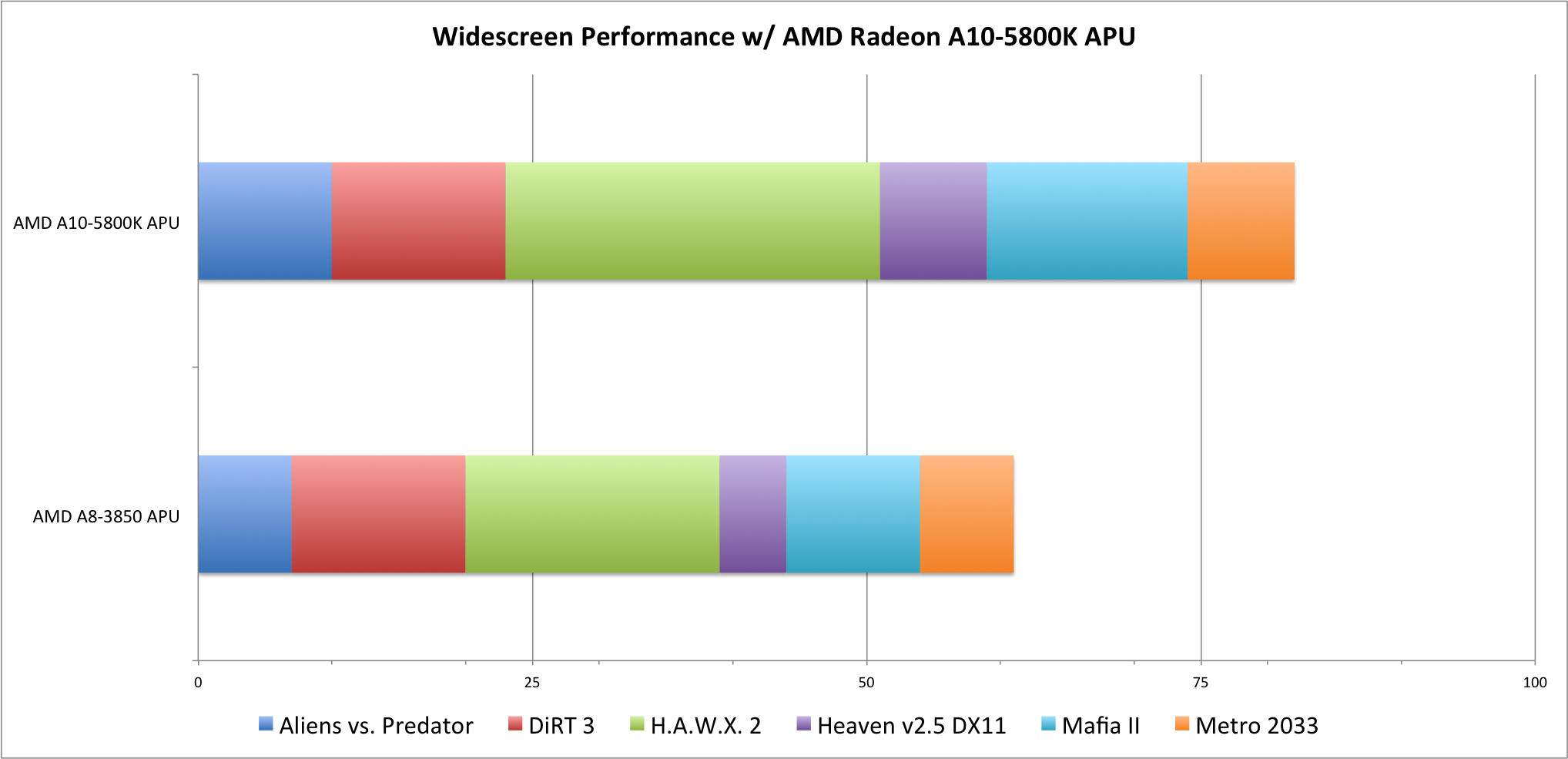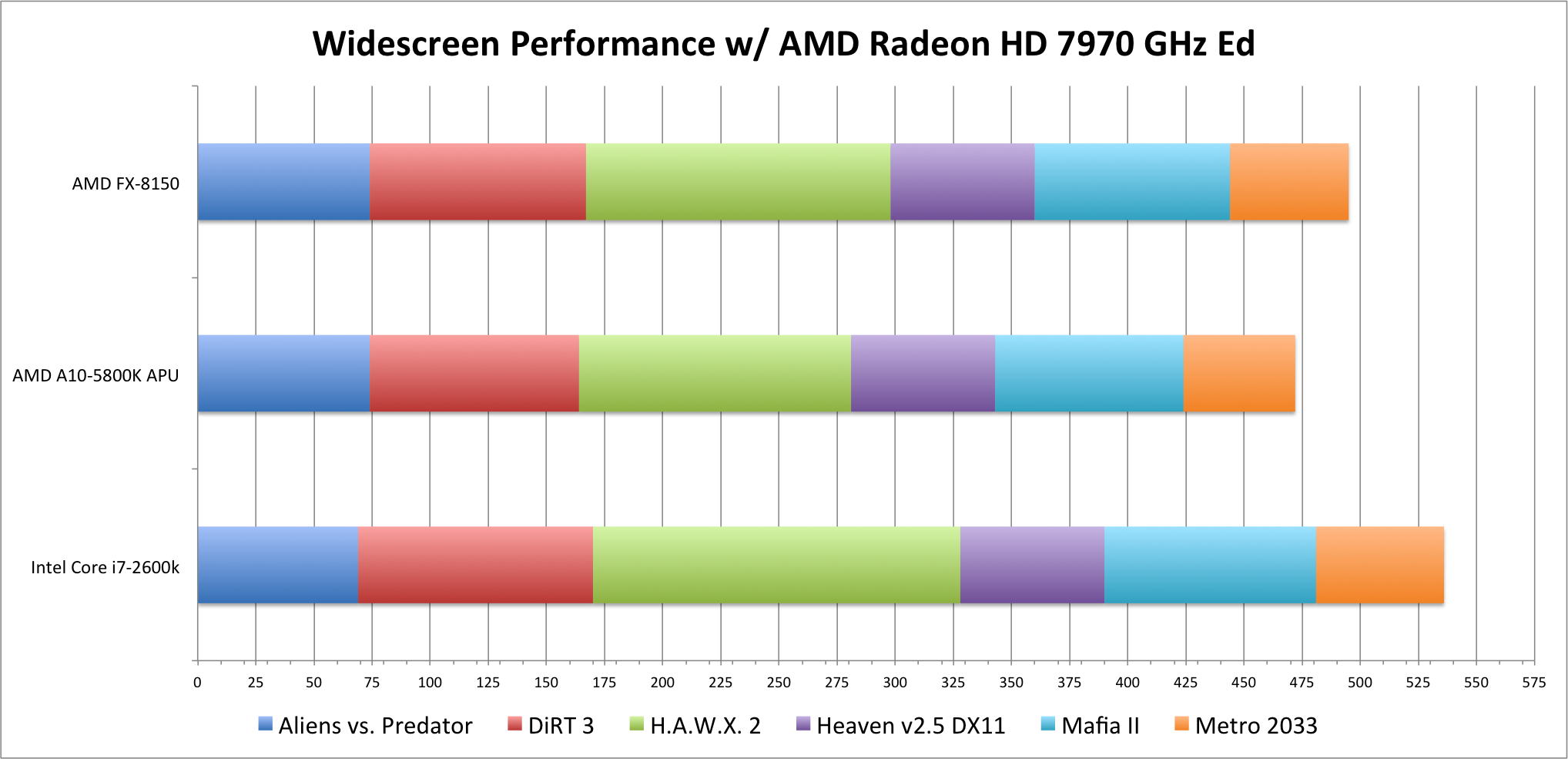AMD Trinity A10-5800K Review
Just about a year ago AMD release their first flagship APU, the A8-3850. We reviewed the platform and found it a good product for gamers interested in "indie" titles or mainstream titles running at mid-range settings. Perhaps surprisingly we did find its compute capabilities on par with higher end offerings from Intel, when it game to gaming with a discrete GPU. In that time technology and game design have progressed significantly. What can we now expect from the AMD A10 APU?
I've got to be honest in going into this review, I have developed a bias out outlook/perspective. The CPU comparisons of my A8-3850 review showed me that the AMD A8 APU could keep pace with a high end Intel CPU, when paired with a discrete GPU. We (the gaming community) keep being told that we need the best of the best, in each of our components, to have the best gaming experience. The truth is that much of the power being marketed to us is simply redundant or unneeded. The sum of a gaming rig should be greater than its parts.
There should be a balance of performance where we say some component is "good enough", and additional money should be directed to another component such as a better GPU, SSD or more RAM. Based on my previous look at the A8 APU, I'm betting that the CPUs most people covet are overkill and money is wasted on power that will never been realized. Will the A10 be good enough for today's games, or will you need more? We aim to find out...
Architecture
To be honest, most detailed architecture discussions bore me. I get the high level pieces - X number of cores, Y clock frequency, etc., etc. But at a certain point it becomes more than I care about. What I want are the basic detailed on how the technology has advanced, and what that means to me - in a practical manner.
The AMD A10 APU is an update of last year's architecture found in the A8-3850. It still has a quad-core CPU, though that has been updated to keep in line with AMD CPU advancements over the last year. The integrated GPU has been upgraded from a Radeon HD 6550D, to a Radeon HD 7660 HD. This sounds like an upgrade I can understand, considering that we benchmark GPUs in each generation.
The GPU cores in the new chip only have 384 "stream" processors, versus 400 in the A10. However, they run at 800Mhz, versus the 600 MHZ in the A8. Also, the Radeon HD 7660 HD core utilizes the "Graphics Core Next" architecture of the Radeon HD 7000 series, which is supposed to be inherently better than the previous generation. Additionally, you can add in a Radeon HD 6670 GPU for a dual-GPU configuration.
| Platform | Series | Model | CPU | GPU | ||||
| Core | Freq. | Cache | Model | Config | Freq | |||
| Brazos | Zacate | E-350 | 1 | 1.5 GHz | 512KB | HD 6310D | 80:8:4 | 500MHz |
| Llano | Lynx | A8-3850 | 4 | 2.9 GHz | 4x 1MB | HD 6550D | 400:20:8 | 600MHz |
| Virgo | Trinity | A10-5800K | 4 | 3.8 GHz | 4x 1MB | HD 7660D | 384 | 800MHz |
My glossy-eyes take:
- It's got a quad-core CPU, which appears to be the baseline requirement for a high-end CPU these days. The A8-3850 clocked in at 2.9GHz., while the A10-5800K comes in at 3.8GHZ wth a 4.2GHz "turbo" mode. Considering the A8 performed about as well as my old Intel i7-920 and my current i7-2600k in gaming, I expect the A10 to do just fine.
- The Radeon HD 6550D in the A8 did okay at 1080 gaming, and we've seen significant improvements from the AMD 6k series of discrete chips to the 7k series. The GPU core of the A10 has has fewer processors, but they run significantly faster, and are expected to have additional inherent efficiencies (based on the discrete 7k GPU benchmarks). I expected to see significant improvements here.
If you're into PowerPoint slides, we've got some of those we can share:




Trinity Eyefinity
The A10 APU (codenamed "Trinity") comes with Eyefinity capabilities out of the box. The MSI motherboard AMD supplied came with VGA, DVI, HDMI and DP display connections. Using VGA+DVI+HDMI or VGA+DVI+DP configurations, you can enjoy Eyefinity with the integrated GPU. For my testing I used VGA+DVI+HDMI, using a DVI>HDMI cable for the third connection. There is no option to use an all digital configuration of DVI+HDMI+DP, at least with the MSI FM2-A85XA-G65 mainboard.
While primary useful in productivity settings, I did try a bit of gaming on the A10-5800K in Eyefinity. I was able to run Dirt3 on High settings and 0xAA, at 3x1080p and get 15fps. Dropping the resolution to 3x1600x900 gave me 21fps. Neither of these are truly playable, but they do show the power available in the Trinity APU. I did try dropping the visual quality to Medium, but that only gave me one +1fps at either resolution.
H.A.W.X. 2 ran 3x1080p at max settings, but with 0xAA, at 17fps. Dropping the resolution to 3x1600x900 brought the score up to 22fps. I also took Torchlight II for a spin, running through the first level on max settings. At 1080p it clocked in at 22fps. There are plenty of display options left in Torchlight II that would allow you to push up past 30fps at 3x1080p.

AMD Trinity A10-5800K Review - Testing & Conclusions
Note on Testing
After posting this, one of the Insiders here at the WSGF started asking questions about the A10 and my testing. It came to light that I only used DDR3-1600 RAM in my testing (the RAM which I pulled from my FX-8150). Turns out that with the APU, the speed of RAM can have a noticeable impact on the performance. Using the proper DDR3-1866 RAM, the numbers here should increase by about 10%. So, as impressive as the performance is outlined, it is actually that much better. Sorry about the mistake. I'm certain the floggings are imminent...
APU Gaming Performance
In a pleasant surprise, AMD allowed media outlets an opportunity to offer preview analysis of the A10-5800K. Specifically we were allowed to publish gaming benchmarks of the new flagship APU. While the A10 is targeted at the Intel i3, I don't have one of those to test against. So, I put the A10 through our current test suite and compared it against the A8-3850 from last year.


The A10 flagship APU is 33% faster than the previous king of the lineup, the A8-3850. However, in our stress testing (which is designed to humble discrete GPUs), the A10 didn't produce truly playable framerates in any instance we tested. Please note, the testing we normally perform isn't geared towards this type of product. So, I set about making adjustments to the quality settings in our test suite and found that in several of the titles hit a playable 30fps with only slight adjustments.
Dirt 3 and HAWX 2 were able to hit a solid 30fps (with Dirt 3 able to maintain a verifiable minimum above 30fps) with only minor adjustments to the quality settings. Still maintaining "High" settings, the A10 APU was able to provide a solidly playable experience.
Additionally, I did a second round of testing on additional popular/mainstream/indie titles. As an update to my testing of the A8, I looked at Deathspank, Guild Wars, Orcs Must Die! and Torchlight. In the spirit of testing sequels I also looked at Guild Wars 2, Orcs Must Die! 2, and Torchlight II. I also looked at Jet Set Radio HD (remake of one of my favorite Dreamcast titles).
I found that the A10 offered consistent performance improvements over the A8 (tested at 1080p). However, in most instances the A8 was already playable in the original titles I tested. Testing the A10 in the series of sequels confirmed that the AMD A10 APU has enough power to consistently delivered 30fps+ in currently popular titles.
CPU Performance
If you look around the Interwebs at CPU reviews, you will find a lot of different programs used to test CPU power: Cinebench, SiSoft Sandra, Handbrake, WinZip, 7-Zip and various takes on H.264 video encoding. These tests do a great job at testing the raw power of the silicon, I have my doubts on how they translate into real-world usage and actual return on your investment. How well do those results translate into common daily tasks, and more importantly - gaming?
How many of us are using tools like Cinema 4D (the basis for Cinebench) or Maya to make movies or games? Handbrake is something that a lot of people might use on a routine basis. But I haven't ripped a DVD in a long time. With the advent of Netflix, Amazon Prime Video and iTunes, I rarely buy physical media. Looking at WinZip, I rarely use it. I use Windows "Send to Compressed Folder" for the few instances I share a handful of screenshots across Dropbox.
Most of the CPU tests used are highly optimized apps that take real advantage of the multi-threading capabilities found in multi-core processors. Conversely, most of the apps we use on a daily basis, and most of the games we play aren't that well optimized. I think CPU testing should reflect a real, honest use-case of your daily computing. My guess is that like me, most of you use your PCs for email, web surfing, using Google docs (or some equivalent), and gaming.
Ultimately we are a gaming site, so we will focus on games for our CPU tests. In my opinion a CPU should be tested with regards to how it marries with a GPU. Remove the GPU bottleneck by using the best GPU you can find, and see how games perform.
To this end, I took our test suite and benchmarked each CPU with a Radeon HD 7970 GHz Edition installed. I ran each title at 1080p and 3x1080p Eyefinity.




In widescreen, the A10 clocks in 5% slower than it's bigger brother the FX-8150. The top-end Intel i7-2600k is almost 14% faster than the A10 APU. In Eyefinity, the differences are less. The two AMD chips offer nearly identical performance, and the Intel chip is only 10% faster.
Digging into the data a little bit, we find that almost all of the Intel advantage comes from its improved performance in H.A.W.X. 2. The boost in performance for H.A.W.X. 2 is ironic, as it's really not needed. In our testing the A10 almost hit 120fps in single screen, and almost hit 60fps in Eyefinity. The push above 60fps in Eyefinity is certainly a nice benchmark, but push from 117fps to 158fps at 1080p is certainly superfluous.
If we remove the H.A.W.X. 2 data from the analysis (considering it is not indicative of how other titles perform), we find that the Intel i7-2600k is only 6.5% faster in single screen, and less than 1% faster in Eyefinity.
Conclusions & Final Thoughts
| Price | Widescreen | Eyefinity | ||||
| Frames | Frames/$$$ | Frames | Frames/$$$ | |||
| AMD A10-5800K | $129 | 472 | 3.66 | 232 | 1.80 | |
| AMD FX-8150 | $189 | 495 | 2.62 | 231 | 1.22 | |
| Intel i7-2600k | $299 | 536 | 1.79 | 257 | 0.86 | |
The AMD A10-5800K APU is a damn fine product. It offers a great combination of features at a very attractive price. Out of the box you can use Eyefinity for productivity tasks, and you get decent gaming performance on a single screen.
As long as you have reasonable expectations (30fps), and don't expect to have all the eye candy, the integrated GPU in the A10 will give you a good 1080p experience - all without the need for a discrete GPU. For someone on a budget, the A10 provides a great place to start when building a gaming rig.
When we do add a discrete GPU, we find that the A10 holds its own quite well. It's not the fastest chip on the market, but it doesn't lag that far behind flagship CPUs from either AMD or Intel. The real kicker is that it provides this performance at 2/3 the price of the AMD FX-8150 and less than half the cost of the Intel i7-2600k.
So, what can you do with the money saved? For the $60 saved versus the AMD FX-8150 you could pick up a 64GB SSD or some extra RAM (8GB costs less than $40). Or, you could invest in a good gaming mouse, or get a better keyboard.
For the $170 you'd save over the Intel i7-2600k you could get a 128GB SSD, or a gaming mouse/keyboard combo such as the Corsair K90/M90 set. With that much money you could also invest in a much better GPU, or work towards your Eyefinity/Surround setup by picking up another monitor.
The AMD A10 APU launches at a great price, and delivered stellar real-world gaming performance. This combination results in an amazing price/performance ratio, and the A10-5800K can serve as the foundation of great, balanced system build. For this, the A10-5800K is highly recommended from the WSGF.
